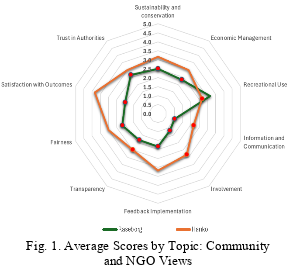
Natural Resources Management
The Novia Natural Resources Managment blog features peer-reviewed posts authored by NRM graduates and their supervisors. Its aim is to disseminate pertinent insights and findings from NRM thesis research. Posts are selected for their relevance to professionals in the field or the general public. All blog entries undergo review by a faculty editor and subject matter experts.
Reviewed blogposts are marked.
We follow CC BY 4.0 if nothing else is stated.
From Trees to Trust: Lessons from two Finnish cities

Picture: Generated with DALL·E, an AI tool by OpenAI, 2024.
Finland is a country of forests, central to its identity, economy, and environmental policy. While public discourse often focuses on state-managed or privately owned forests, which together cover nearly 90% of the country’s forested land (LUKE, 2021), municipal forests have received less attention, despite their unique role in local governance and daily life.
Although less than 2% of Finland’s forested area, these are often the forests close to people’s homes and are used for recreation, education, and community events. For those who don’t own a forest parcel of their own, these are the only forests whose use they can meaningfully influence upon. Managed by municipalities, these forests represent a space where sustainability decisions are made close to home.
While global and national directives guide sustainability, Finnish law leaves municipalities to interpret how to balance ecological, economic, and social goals in forest management. Research shows that these priorities are not always treated equally — and public participation remains limited, especially in smaller towns (Piipponen & Pekola-Sjöblom, 2019; Anttila, 2021; Visuri, 2020; Pappila & Pölönen, 2012).
Conflicts often arise when stakeholders’ priorities differ: communities value recreation, authorities focus on revenue, and scientists stress biodiversity. Discrepancies can further heighten tensions when one set of values dominates over the others.
Sustainability isn’t just about international agreements — it’s about what happens near someone’s home, in what they call “our forests. It’s in these places that people feel most connected and, at the same time, may feel quite powerless. So, when people feel something is being taken away from “their” forest, it’s not about just trees—it’s about trust.
This intersection makes municipal forest governance an excellent opportunity for studying sustainable forest management, trust in local decision-making, and public participation. The Master’s Thesis “From Trees to Trust: Exploring Community Perceptions of Municipal Forest Management in Two Finnish Municipalities” was motivated by a simple but important question: “Is local forest governance perceived as fair, inclusive, and sustainable?”
The study focused on two municipalities in Uusimaa—Hanko and Raseborg—each with a recent history of public debate on municipal forest decisions. Their cases offered an opportunity to explore how key stakeholders experience forest planning processes and whether a shared understanding, or persistent gaps, exist regarding sustainability, transparency, and trust.
Shaping the Study: Not Just Data, But Dialogue
The study combined a 5-point Likert scale survey with in-depth interviews, engaging stakeholders as partners in dialogue. Respondents from community groups, municipal authorities, and NGOs/scientists were intentionally selected to reflect the three pillars of sustainability: social, economic, and ecological. Selection focused on individuals with direct experience in forest-related planning, governance, or activism.
ATLAS.ti software supported the qualitative analysis by identifying key themes and helping reduce interpretive bias, ensuring that all perspectives were heard equally.
This approach brought forward rich and open conversations. Many respondents welcomed the opportunity to reflect critically on their municipality’s forest policies. Their willingness to share made it clear: this subject matters deeply.
Where Policy Meets Perceptions
The study revealed both expected patterns and surprising contrasts in how stakeholders perceive municipal forest governance - not only as an issue of nature management, but also of trust, fairness, and identity.

Different Cities - Different Perceptions. Hanko was perceived as more balanced and responsive. The ban on clear-cutting and easier access to decision-makers fostered a sense of inclusion, despite some shortcomings in strategic planning.
In contrast, Raseborg stakeholders - NGOs and community members - were less satisfied, citing a dominance of economic priorities, limited transparency, and minimal engagement.
Perception Gaps: A Barrier to Consensus. In both municipalities, authorities expressed confidence in their practices, but NGOs and community members felt left out of key decisions. These gaps were more critical between municipal authorities and NGO/scientist groups, especially in Raseborg, over transparency, ecological responsibility, and inclusion. Hanko, while not free from criticism, showed more openness and willingness to adjust.
An important gap also emerged between community members and NGOs in both cities, with the latter being consistently more critical and stronger advocates for biodiversity preservation and deeper systemic reform.
A recurring theme was psychological ownership. Residents and NGOs often spoke of municipal forests as “ours,” expressing their desire to be part of decisions that affect these spaces. Authorities, by contrast, tended to frame ownership in institutional or administrative terms, which widened the perception gap.
Meaningful Insights:
- Clear-cutting: Strongly opposed by both NGOs and residents.
- Personal influence: Forest engineers and board members influence outcomes through their values.
- Labeling of the greens: Environmental voices are often dismissed, discussions are polarized.
- Call for environmental offices: A need for a stronger, more independent role.
- Media’s role: crucial for transparency and informed public discussion.
- Education: A shared need for both officials and residents to better understand biodiversity and participatory governance.
Municipal forests may be small in size, but they reveal bigger questions about power, identity, and how we define sustainability. See the full thesis document for more details, full stakeholder quotes, discussions, and visual data comparisons.
More Than Trees: A Closing Reflection
A few respondents asked if it was a “tree-huggers’ research”. Obviously, a researcher’s role is to be fair and to ensure that no single voice dominates. Still, the deeper challenge remained: how to study conflict without becoming part of it and how to present criticism without losing trust.
This thesis focused on two Finnish municipalities, but the questions extend beyond them. Forest governance is inherently political. Decisions made by forest engineers, city officials, and local councils shape ecosystems and trust for decades, often without residents realizing how much is at stake in local elections or planning meetings.
Finally, it is about how we can govern shared nature in ways that include, not exclude. Evidently, the disagreement is a part of sustainability’s reality. And on the path to sustainability, all voices count — not just those of people with power, but also those without words: the birds, the trees, and the generations to come.
Dunaeva, T. (2025). From Trees to Trust: Exploring Community Perceptions of Municipal Forest Management in Two Finnish Municipalities. Thesis for Master of Natural Resources, NOVIA UAS. https://urn.fi/URN:NBN:fi:amk-202503204668
Other sources:
Anttila, T. (2021). Kuntien metsäsuunnittelussa käytettyjä osallistamismenetelmiä ja kokemuksia osallistamisen toteutuksesta. Pro gradu-tutkielma Helsingin yliopisto. Metsätieteiden maisteriohjelma Metsien ekologia ja käyttö. Retrieved from https://helda.helsinki.fi/server/api/core/bitstreams/8bf3948c-a948-43e6-a815-9b36648c54b6/content
Pappila, M., & Pölönen, I. (2012). Reconsidering the role of public participation in the Finnish forest planning system. Scandinavian Journal of Forest Research, 27(2), 177–185.
Piipponen, S-L. & Pekola-Sjöblom, A. (2019). Osallistaako kunta, osallistuuko kuntalainen? Uutta kunnista -julkaisu nro 3/2019. Suomen Kuntaliitto, 44.
LUKE (2021). Finnish Statistical Yearbook of Forestry, 2021. Retrieved from: http://urn.fi/URN:ISBN:978-952-380-325-1
Visuri, V. (2020). Kokonaiskestävä kuntametsä -hanke: Kyselyn ja haastatteluiden yhteenveto. http://www.kuntaliito.fi/file/25523/download?token=5RiK9ESq (retrieved: 01.10.2024).
Short biography of Authors:
Tatiana Dunaeva is the main writer of this thesis. She completed both her Bachelor’s and Master’s studies at Novia University of Applied Sciences, focusing on natural resource management and sustainability. With a professional background in forest inventories, protected areas, and community-based environmental projects, Tatiana has international experience in forestry and a strong interest in sustainability transitions, participatory governance and environmental communication.
Dr. Stefan Heinänen is the co-author and supervisor of this thesis. He is a Senior Lecturer, Head of the Degree Programme in Sustainable Coastal Management, and researcher at the Faculty of Bioeconomy at Novia. Stefan is a spatial ecologist with expertise in species distribution modelling, GIS, statistical applications, and spatial planning. He has worked on various applied ecology international projects dealing with human-nature interactions in coastal or marine environments.
The blogpost has been reviewed by Novia's editorial board and accepted for publication on 28.5.2025.![]()
Natural Resource Management
The Novia Natural Resources Managment blog features peer-reviewed posts authored by NRM graduates and their supervisors. Its aim is to disseminate pertinent insights and findings from NRM thesis research. Posts are selected for their relevance to professionals in the field or the general public. All blog entries undergo review by a faculty editor and subject matter experts.
Reviewed blogposts are marked.
We follow CC BY 4.0 if nothing else is stated.
Disclaimer: The author(s) are responsible for the facts, any possible omissions, and the accuracy of the content in the blog.The texts have undergone a review, however, the opinions expressed are those of the author and do not necessarily reflect the views of Novia University of Applied Sciences.